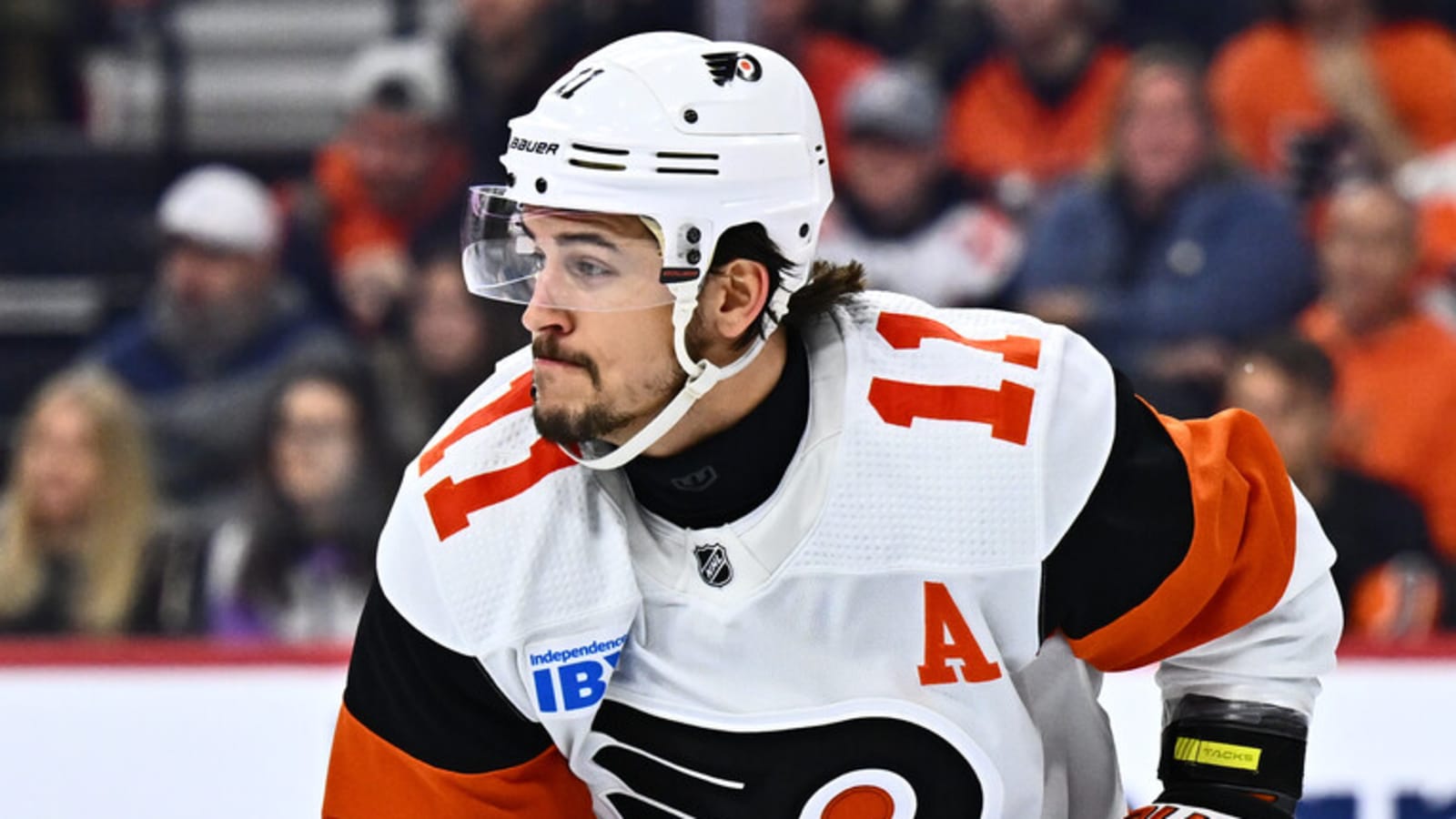On July 25, 2024, 27-year-old Travis Konecny signed what is now the biggest contract in the history of the Philadelphia Flyers: eight years, $70 million ($8.75 million average annual value)—it comes with trade protection and will begin in 2025-26. On the surface, it is objectively one of the worst deals handed out by any team this offseason, if not the worst. But is it really?

Based on his numbers and what he is as a player, Konecny got too much money and way too much term from general manager (GM) Danny Briere—but that’s not the point of this piece. Let’s try and understand the Flyers’ perspective.
Konecny Was Overpaid, But That Might Be Okay
In order to have a good-faith argument, we must establish one thing: players like Konecny do not tend to age well. He is the exact replica that Carolina Hurricanes GM Eric Tulsky said tends to fall off the fastest in an article from 2014. Konecny doesn’t have a high hockey IQ, he does basically all of his scoring at even strength, and is a goal-scorer—all things that were highlighted. While that piece is on the older side, the themes are still true and mostly depend on common sense, anyway. Someone who mainly uses his legs and athleticism to make a difference on the score sheet, that’s something that will inevitably fade for Konecny. And possibly sooner than later.
Konecny’s style is very similar to Cam Atkinson’s when he was in his prime, and we of course know how that situation ended. When the latter lost the athleticism that originally earned him his contract, he became a liability at both ends of the ice at even strength and was bought out. Both have been rush-dependent scorers for their entire careers but possessed a bit of in-zone upside when they had good teams around them. Still, when that athleticism faded for Atkinson, he was no longer a threat on the rush—he lost his entire game, and that’s what will almost definitely happen to Konecny at some point.
This assessment is closer to realistic than pessimistic, unfortunately. By the fifth or sixth year of his contract, Konecny probably won’t be the same player, and perhaps unusable altogether by the seventh or eighth year. Once you get to your mid-30s, the rush game isn’t the same anymore. Ask Sidney Crosby, who went from scoring a decent chunk of his goals on the rush in his 20s to being a dominant in-zone scorer in his 30s. Since he has generational hockey IQ, he was able to make that transition.
These things are all important to consider for context. But if we really assess Konecny, maybe it’s not all doom and gloom. Perhaps there’s some light at the end of the tunnel.
Konecny has basically scored at the same points per 60 (P/60) rate since his age-20 season, regardless of the talent around him. Even assuming that the Flyers give him better linemates, which is unlikely since he and 19-year-old Matvei Michkov play the same position, the scoring won’t change too much. But maybe that’s not the point.
It will take some time for Michkov to be able to handle the ice time that Konecny was routinely playing from 2022-2024. Averaging 19:58 of ice time in that span, relying on a 19-year-old so quickly might not be the best for his development. It’s good to have options, so theoretically having two dependable top-six lines is smart in theory. You know what you’re getting with Konecny versus someone else being thrust into that role. If he can handle top-line matchups, he can handle anything.
It’s also important to recognize that Konecny makes important players around him better. Looking at all of the forwards aged 25 and under with which he played 250 or more minutes of 5-on-5 ice time, his teammates vastly improved by his side.
For the stats comparison, we’ll use relative expected goals percentage (xGF% Rel), relative Corsi percentage (CF% Rel), and relative goals percentage (GF% Rel)—a glossary for those stats can be found here. Percentile-wise among all forwards in the NHL in 2023-24, what did Konecny bring?
| Stat (5-on-5) | Foerster with vs. without Konecny (Percentile) | Tippett with vs. without Konecny (Percentile) | Frost with vs. without Konecny (Percentile) |
| xGF% Rel | 93rd vs. 54th | 68th vs. 37th | 79th vs. 60th |
| CF% Rel | 96th vs. 63rd | 86th vs. 46th | 73rd vs. 46th |
| GF% Rel | 79th vs. 78th | 97th vs. 22nd | 97th vs. 57th |
There have been no signs to indicate that Konecny will fall off a cliff immediately. In fact, last season was probably the best of his career. He should help those around him achieve their maximum potential for a little while longer—trading him would have meant sacrificing the development of players like Tyson Foerster. Is that something the Flyers really want, even if Konecny might not be what he is today in his mid-30s?
As well, the Flyers were going to need a Konecny-esque offensive threat anyway. Many long-term deals in free agency tend to age rather poorly by the end of the contract, as that’s just how the human body works. So, Konecny is basically a de facto free-agent deal that the Flyers would have needed anyway. This is a point to revisit later and why Philadelphia might have done this, but just remember it for now.
Konecny’s Off-Ice Impact
Signing a player solely for their impact off of the ice is a bad idea, almost always. But the fact that Konecny is beneficial to the team’s culture and is well-liked in the Flyers locker room is an undeniable fact. More than any free agent, the 27-year-old has a sentimental impact to the fans and his teammates alike. Would trading him have sent the wrong message? That’s something Briere chose not to find out.
Players like Konecny, who has essentially taken the torch from Wayne Simmonds in terms of his charm and leadership, are coveted around the league. What made someone like Simmonds so valuable went beyond just on the ice. When he was traded, the Flyers lost a piece of themselves; they lost their identity. Konecny is the same type of player in the sense that he is well-respected in the locker room and by the fanbase. On the surface, a 27-year-old winger with a 68-point career-high on awful defensive efficiency should not be making more money than a 28-year-old winger who scored 67 total goals and finished fourth in Selke Trophy voting last season—this much proves how serious the overpayment is, especially since the deals were signed three weeks apart. But it’s deeper than that.
Sometimes, there is a human aspect to sports. The Flyers played some of their most inspired hockey in years last season, and Konecny played a big role in that. Trading him could have destroyed the Flyers before they really even got a chance to spread their wings. In essence, the contract is not about the money; it’s about the player. When a player is that important to your locker room, sometimes you have to bite the bullet.
How Can the Flyers Maximize Konecny’s Value?
The Flyers can maximize Konecny’s value by doing one thing, which is something I argued they were already doing about a month ago: retooling. With this extension, it is clear that this is their process. It was a short rebuild, but those days are over. The Orange and Black are trying to win.
If the Flyers plan to win in Konecny’s window, then the extension isn’t all that irrational. It’s still an overpayment, but trying to at least be a contender during the years when he will provide the most makes a lot of sense. The whole point of a contract like this is to win right away, and that seems to be what the Flyers are doing.
If the Flyers are indeed retooling, we can expect them to start pulling off some “hockey trades” and make moves to acquire a solution down the middle—this seems to be their biggest weakness. Since Konecny should still have a few good years left in theory, there’s time to accomplish this. Michkov will continue to get better, players on the roster will improve, prospects will graduate to the NHL, and there will be offseason additions. Theoretically, the Flyers would be improving through the draft after every season whilst also being competitive year after year. Eventually, a few good playoff runs are inevitable—you can’t fulfill this vision to its best without Konecny. If this is the vision, the contract is easier to swallow.
It’s about split as to whether or not Konecny is overpaid, but if we ignore the value for a second, it’s easier to appease everyone. The 27-year-old has positive traits and could be important to the Flyers’ process, which is likely why they were so insistent on paying him.





